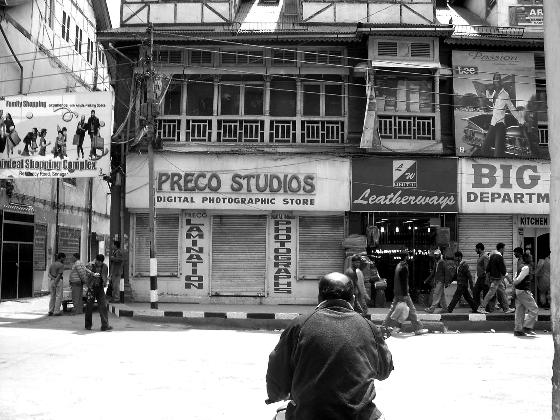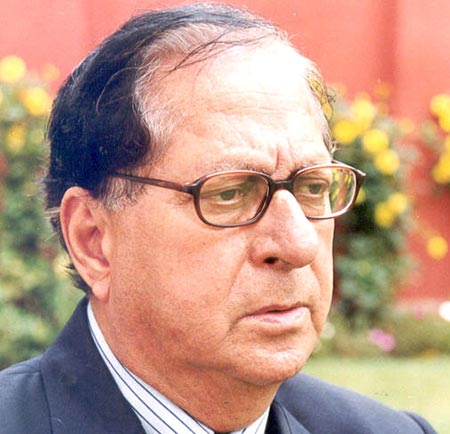As Café Coffee Day’s entry in Kashmir brews up the competition with the few existing outlets, Shazia Yousuf traces the history of the coffee house culture in Srinagar.

The wooden staircase would lead to a wide dimly lit hall. It was a place where heated political debates would breathe over the hazy smoke when a poem or plot of a story was being conceived on some corner table of the hall. The walls were unornamented yet glistening with the discourses of politics and poetry. Political inclination would be born, and reborn, with the aroma of coffee hanging in the air. It was a place where thoughts would be conceived, concealed and sometimes stolen too. This was coffee house that once housed political and intellectual debates of this place.
Set up by Indian Coffee Board, the Coffee House was located on Residency Road near Ahdoos Hotel. In late 1960’s it was shifted a few paces down the same street to the first floor of a building opposite Chand Chinar temple. The place later became Hot Breads – a bakery and fast food restaurant. Now ready-made garments are sold there.
Frequent visitors included writers, poets, painters, dramatists, artists, musicians, politicians, journalists, college teachers and amateurs.
“We would call it a samanbal (meeting point), journalists, politicians and artists would meet and discuss. Since there were only few local newspapers and national newspapers would prefer Pandit correspondents, the majority of journalists there would be Pandits. But then Muslims too had couple of publications to rely on, like Aftab and Aa’ina. There would be always hot debates with the tinge of religious and political overtone. It was always smoky and heavy,” recalls Zareef Ahmad Zareef.
After long discussions, the intellectuals would disperse and stroll along the Bund.
Eminent personalities like Shameem Ahmad Shameem, Safdar Hashmi, Ali Mohammad Lone, Ghulam Rasool Santosh, Ghulam Nabi Khayal, Akhtar Mohi Ud Din and Rehman Rahi would spend hours in the coffee house. The Pandit journalists representing national press would form an important part of it.
“I remember the tables were fixed. The first table facing the entrance was ours. It was called intellectual table and was hottest of all. On its right side, Punjabi businessmen would sit. The hall accommodated almost 60 people. There was corridor where those who didn’t like discussions would sit there,” recalls Ghulam Nabi Khayal.
“A cup of coffee worth 50 paisa was a license to be part of those lingering discussions. The staff at the coffee house being south Indian would serve south Indian dishes like Idly, Wada. However, Masala Dosa was a favourite. It would cost 1.50 rupees.”
It was a delight when somebody would feel hungry and order Masala Dosas for all, Khayal adds. “Most of the time we would have no money, but they would allow us to have coffee on debit.”
Staff members like Guruji and Ghulam Qadir are still remembered. It was customary to greet Guruji with Namaste on entering the hall and calling Ghulam Qadir for coffee.
Renowned Indian painter Maqbool Fida Hussain, on his Kashmir visits would come to the Coffee House with his friend and prominent Kashmiri artist Ghulam Rasool Santosh and discuss art and literature. The other literati who would be part of the discussion include Shamim Ahmad Shamim, Ali Mohammad Lone, P N Jalali, Akhtar Mohi-ud-din, Sham Koul, Ghulam Nabi Khayal.
It was one day there that Ghulam Nabi Khayal challenged M F Hussain to make his own portrait. He took a note book and made a sketch of himself and gifted it to Khayal. “It was not with the intention of challenge, I just thought how an artist looks at himself – what is his image of self. I was shocked when he handed over the sketch to me. It looked as if a mirror was placed before him,” recalls Khayal.
Khayal says he has preserved the sketch not only for the brilliant artist but for the place that would assemble those brilliant minds. “For me, that sketch is a piece of history. It smells of those minds that would decor that dark hall which was an institution in itself.”
Recalling the bitter sweet memories of coffee house, Zareef shares an anecdote when Gul Denti, a middle aged mechanic and a frequent visitor to Coffee House heard about guerrilla war and mistook it as Gwalior, “I will not let Gwalior people rule this place. This is our valley we will rule this, he shouted and we burst into laughter,” says Zareef.
 The deafening sound of a grenade in late 1980’s silenced the Coffee House. With the migration of half of its Pandit devotees to Jammu the other half couldn’t even think of an alternative. “Nobody knows who coped how. People who would sip and puff together feared to see one another after that. It was the time when a person would be detained just because he talked to someone on street. No matter what,” says Zareef.
The deafening sound of a grenade in late 1980’s silenced the Coffee House. With the migration of half of its Pandit devotees to Jammu the other half couldn’t even think of an alternative. “Nobody knows who coped how. People who would sip and puff together feared to see one another after that. It was the time when a person would be detained just because he talked to someone on street. No matter what,” says Zareef.
The Indian Coffee Board established an outlet at Jammu in 1991. “I went to Jammu and saw migrant Pandits discussing in that newly established coffee house. They were talking with the same passion as they used to. But I didn’t feel like joining. I was missing our Coffee House,” recalls Rehman Rahi.
However the Jammu outlet didn’t run for long. After a few months, Indian Coffee Board pulled down the shutters.
Rahi holds closure of Coffee House responsible for the “psychological inhibition” among intellectuals and literary class. He says lack of dialogue and exchange of ideas has made both literary as well as common man resistant to changes. “Where is free dialogue? Where is democratic atmosphere? There is no system of criticism, everyone thinks of himself as the best. I don’t think anybody is enough patient to bear the criticism we used to have in coffee house,” he says.
Many college and university students who would visit Coffee House to have glimpses of their favourite writers have become writers themselves. Columnist Zahid Ghulam Mohammad credits his writings to the Coffee House. The idea of the first article written by the author, he says was conceived in the Coffee House and got published in Statesman (Calcutta) in 1973.
“My reason of going to Coffee House as a student was the inspirational writings of Shamim Ahmad Shamim. Though I wouldn’t dare to speak before that galaxy of intellectuals, I loved to be part of that debate even if I had nothing to say,” he says.
G M Pampori retired government employee, who was in college then recalls, “I was a regular reader of newspapers. Somebody told me that writers spent their evenings in Coffee House. I still remember my hesitantly climbing that wooden staircase with smoke and the aroma of coffee coming out. I had just developed the habit (of visiting it) when the insurgency began and the Coffee House was closed,” says Pampori.
Though people like Pampori have, at least, reminiscences to cherish, the generation late by a decade or so has not even those. “For me it was Hot Breads, the place where I loved to eat and discuss with my friends. Whatever we would start with, our discussions would always end up in hot political debates. Not all of us will leave together home. Couple of people will always leave the food half way in annoyance,” says Aijaz Ahmad, an IT professional.
Aijaz says that it was only one day while apologizing to a friend for being harsh that an elderly person sitting behind them laughed and narrated the glorious past of the place to them. “I told my friend that the place is possessed with some political ghost and the man from the other table laughed and told us about Coffee House,” recalls Aijaz.
It was after many years when an aromatic respite came to Srinagar in the form of a westernized coffee house – Coffea Arabica. Owned by K K Amla, the coffee house is part of Broadway hotel.

Named after the most widely consumed variety of coffee in the world, Coffea Arabica came as respite. The cafe has already become a popular tourist haunt. Many foreigners particularly journalists and film makers could be seen blending in the westernized inside. “Apart from local and foreign journalists and tourists, our clients are businessmen, college students, government officials and even children, though our target has always been young crowd,” says Amin Wani, Manager, Coffea Arabica.
“The ambience is soothing; it is modern and pure at the same time. A blend. Jazz music echoing on the raw smoked walls, it feels amazing,” says Fahad a regular visitor.
“Though I come for the sole purpose of entertainment but I see many intellectuals and journalists here,” Fahad adds.
The café serves wide variety of flavoured teas besides a range of coffees – Cappuccino, Espresso, Mocha.
Another café, named over a less expensive variety of coffee, Café Robusta lies at the distance of few hundred meters from Coffea Arabica.
On December 3, Bangalore based, Café Coffee Day inaugurated its first outlet at Sonwar in Srinagar. Café Coffee Day is part of India’s largest coffee conglomerate, Amalgamated Bean Coffee Trading Company Ltd.
The outlet provides specially prepared signature coffee blends and recipes, “Apart from coffee we offer fast food items like snacks, sandwiches, pastries, desserts, and ice creams,” says Bilal Khan, Assistant Manager, Café Coffee Day.
Some years back Jammu and Kashmir cultural academy announced to revive Coffee House in Kitab Ghar. Another attempt was the setting up of press club in Sher-i-Kashmir park. Both failed to materialise.















